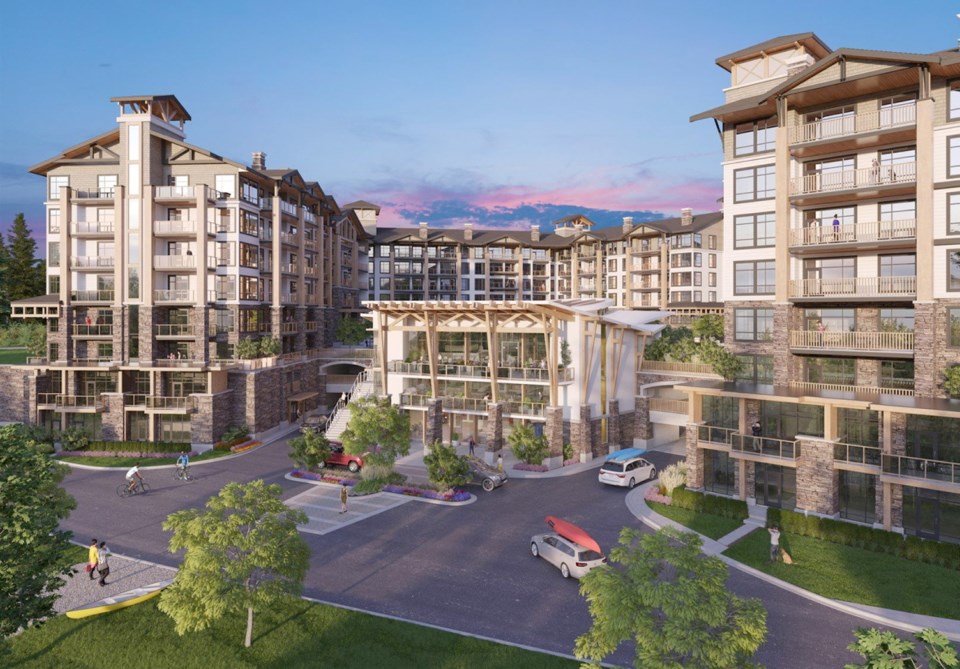The district of Langford, which has hummed along under the din of constant construction for the past several years, will add a little more noise to the mix this fall as an 869-unit complex starts to come out of the ground.
Toronto-based Liberty Ridge Homes is about to start work on the first phase of its four-phase Aqua project at the western edge of Langford Lake, a project the developer credits to the work of Langford’s council in getting the word out that the region is open for business.
“This is an interesting place to invest from our perspective,” said Liberty Ridge president Richard Weldon.
“We see this as the time for B.C. to shine. From our perspective, we are invested across the country, but we like Langford and we like Vancouver Island and we saw this as a good opportunity to get in early in Langford.”
Liberty has already been at work building townhouses in Kettle Valley in Langford.
Weldon said the infrastructure in the municipality — new schools, new recreational facilities, a larger commercial base and improved transportation infrastructure — sold the company on the region.
The first phase of Aqua will see two condominium buildings, with a total of 360 units, start this fall.
The sales centre is slated to open in two weeks, offering units with a median price of about $350,000.
“We have every confidence, first of all, in the B.C. economy and every confidence in the City of Langford,” said Weldon, noting the population of the region is projected to increase significantly over the next few years.
“And there is a shortage of quality accommodation that is affordable.”
According to the city’s website, Langford is projecting its population will grow to 42,000 by 2026 from 18,840 in 2001.
“It’s a great time to be in the market and we think the market can handle this size of project,” Weldon said, noting they expect the full buildout of 869 units will take between five and seven years. The first phase is to be completed in about 14 months.
Langford Mayor Stew Young said it’s no surprise developers from across the country have found the region.
“Langford is getting known. We have the natural beauty — we have three lakes in our core — we have the land and we are promoting it,” he said. “We have an economic development group that is showcasing Langford.”
The municipality has also developed a reputation of being builder-friendly.
Langford is the region’s busiest when it comes to building. It has seen 765 new housing units started through the end of September, up from 696 at this time last year. It is well ahead of Victoria, which has seen 665 starts so far this year.
“Langford has become the municipality of choice for developers and builders because they add certainty to the process,” said Casey Edge, executive director of the Victoria Residential Builders Association.
“If they have an issue with a project, they will be transparent about it, while other municipalities, frankly, just aren’t.”
Edge said when it comes to large projects such as Aqua there are a lot of costs involved and developers cannot afford to have it held up for a couple of years in a process that isn’t clear.
Young said they have had a lot of success in attracting developers and establishing the infrastructure (schools, recreation facilities and improved-if-not-perfect transportation links) needed for the growing community, but his focus is now on bringing jobs to Langford.
“We have the land and infrastructure and I want to get people out of the commute; if I create the jobs here, the less [people] will have to commute,” he said.
“We have a bright future here. Our job as a city is to chase jobs for the people and bring as much business as we can into Langford.”
Young said to that end they have pushed to have a provincial ministry relocate to the area, have reached out to be the new Canadian home of Amazon, and in partnership with Metchosin rezoned 250 acres as industrial land.
“We are being aggressive and telling anyone with a business that if you want to come out our way we will roll out the red carpet,” he said.
Young said they’ve started to see results as when he first took office 25 years ago the tax base was made up of three per cent commercial and 97 per cent residential. That split is now 20-80.
“That’s healthy for a community,” Young said. “It was terrible before.”



